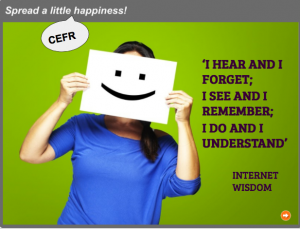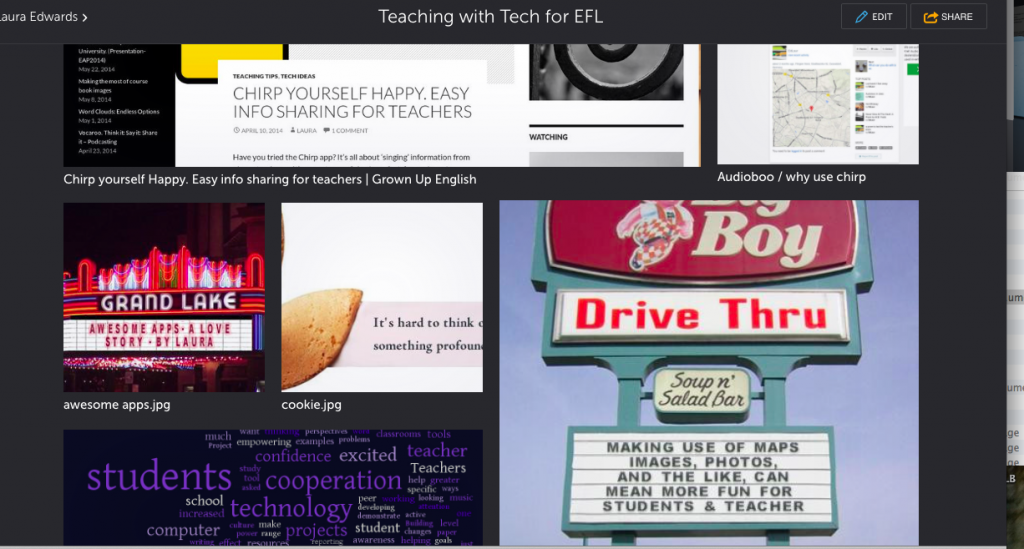You, the expert: An experiment in constructivist, technology-enhanced teaching
Results:
So we negotiated the syllabus, planned our tasks, and started working on the different stages. As I had expected, attendance proved to be the biggest issue. Because of holidays and international projects there were a lot of absences and the project had to be extended by 2 weeks. Of the 6 students in the group, four participated, but by week 5 only 2 had finished their e-book. Despite this, everyone felt very positive about the project and they said that knowing their work would be used in the future made them more attentive to what they were doing. I was delighted with their enthusiasm and the quality of the work they produced, having had little success with writing tasks in the past, particularly those presented in the course book. We also spent a lot of time talking about learning in a way we hadn’t done before.
Difficulties:
For this project I chose tools I was familiar with, which require little digital expertise, but what I hadn’t considered was accessibility. When the students wanted to carry out their interviews they couldn’t access the audio recording site I had asked them to use from their laptops. The problem was easily overcome. None of the students had their phones with them, so we used the voice recorder application on mine instead. It allowed us to make the recordings, but having to use my phone instead of their laptops removed some of their control of the task. When using Vocaroo.com with other groups, I saw students listening to their recordings in class, analysing the results and in some cases, re-recording them. They discussed pronunciation, pace and delivery, as well as vocabulary and grammar, and decided on ways of improving different elements. Being in control of the tool allowed them to do this, and as a result, the process of recording themselves became an important part of the experience.
In this situation neither set of students mentioned or asked about listening to their recordings there and then. They did give each other feedback immediately after the interview, listened to the recordings when I sent them by email and spoke the following week about how useful having the recording was when editing their texts. However, I feel that one important element of the process was lost.
The situation also shows that what works in one environment may not somewhere else, and that for this type of project to succeed, teachers need to be flexible with regards changing or adapting their plans on the spot. As Harmer (2015, p201) reminds us, ‘technological malfunction’ is in itself nothing new, cd players and overhead projectors often broke down at inopportune moments, leaving teachers to improvise or revert to their backup plans. I would argue, however, that in these cases, teachers chose to simply continue with the unit in the book they were working on or wrote up the grammar explanations on the blackboard instead of displaying their pre-designed transparency. The technology was a tool the teacher controlled, in a lesson the teacher planned. The goal of this project was to hand over control to the students, from negotiating the syllabus to creating content future lessons would be based on, and technology was central to that process. If the technology breaks down, the Plan B could lead to the loss of the key characteristics of constructivist instruction. In this case, the alternative available limited reflective practice.
Motivation
‘A good teacher will exploit to the fullest extent all knowledge already available in the classroom’ Clarke, 1991, p18
In the post-project interviews, students mentioned choice as being a key factor in motivating them to carry out the task.
‘I chose a topic that interested me (Iran) because of my business trip in September. I have a personal connection to the topic and this motivated me to do research and share the information with the group.’ Student M
Ryan & Deci say that ‘intrinsic motivation will occur only for activities that hold intrinsic interest for an individual—those that have the appeal of novelty, challenge, or aesthetic value for that individual’ (2000, p60) and choice and self-direction play a huge role in intrinsic motivation. This project was a classroom task set up by the teacher and therefore, involved extrinsic motivation. Ryan & Deci (2000) would, however, class this as integrated regulation. This is the form of motivation closest to intrinsic, for while the push to action comes from an external force, the students evaluate the task or action required of them, and begin to see it as compatible with their own desires or needs. However, unlike intrinsic motivation, the reason for carrying out the task is other than enjoyment in the task in itself.
M was first to perceive the personal value the task would have for him. He referred repeatedly to the fact that in carrying out this task he was simultaneously preparing himself for his upcoming business trip to Iran, a country he previously knew little about.
With participation optional to a certain extent and no grades being awarded, successful completion of the task was dependent on students’ own interest. In this project students played an important role in motivating other group members.
When J joined the class, having been absent for a number of weeks, M was presenting the first draft of his article on Doing business in Iran. J’s role was to read M’s draft, offer feedback and then interview him on the topic. She was very enthusiastic and asked many questions, referencing the nuclear agreement and future trade possibilities between Germany and Iran. After the interview, she told us that as a student she had a professor from Iran who often spoke about life before and after the Islamic Revolution.
M later said that J’s questions helped him identify background information or more detailed explanations that needed to be added. Moreover, taking on the role of editor and interviewer had a motivating effect on J, who immediately decided on the topic she would focus on. She asked if the project deadline could be extended, as although she would be away on holiday for a few weeks, she was eager to participate.
This example shows how the actions and attitudes of group members had positive effects on others. This ties in with Ryan & Deci’s (2000) notion that relatedness, the need for a sense of belonging and feeling of connected-ness, is of vital importance in the case of extrinsically motivated actions.
At the end of the 5 weeks, students returned to the CEFR descriptors they had initially chosen to discuss how they felt they had improved. Breen & Littlejohn (2000) encourage teachers to see communication with students about learning as an essential component of the communicative classroom, and in this case, it was a positive experience, enhancing students’ feelings of competence. In the coming school term, the students will create activities around their projects, using their course book as a model. They could create comprehension questions to accompany the recorded audio, or a follow-up writing task linked to the text. Returning to their work in this way will give them an opportunity for further reflection on their abilities while also supporting their competence.
Conclusion
While the promise of collaboration and deeper learning is appealing, incorporating constructivist practices into the classroom can be daunting. It requires a complete change of role for teachers, less about providing information and more about creating an environment that supports students in exploration and meaning-making. Despite any difficulties, the outcomes of this project have definitely encouraged me to continue on the constructivist path.
Example e-book, Iran – Chance or Change or both? (shared with student’s permission)
https://lauraslearners.atavist.com/iran-chance-or-change-or-both
References:
Breen, M.P. and Littlejohn, A., 2000. The practicalities of negotiation. Classroom decision-making: Negotiation and process syllabuses in practice, pp.272-295.
Clarke, D.F., 1991. The negotiated syllabus: what is it and how is it likely to work?. Applied Linguistics, 12(1), pp.13-28.
Harmer J. The practice of English language teaching. Fifth ed. Harlow: Pearson Longman; 2015.
Ryan, R.M. and Deci, E.L., 2000. Self-determination theory and the facilitation of intrinsic motivation, social development, and well-being. American psychologist, 55(1), p.68.




















